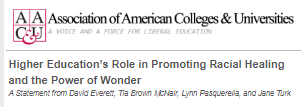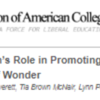As protests erupt across the country and around the world demanding justice for George Floyd, a black man who was killed while in Minneapolis police custody, higher education must play a leadership role in addressing the issues at their center—racism and white supremacy. The devastating video that shows Mr. Floyd pleading for his life follows high-profile news reports of the killing of Breonna Taylor, a young black woman who was shot in bed by Memphis police engaged in a botched search for a drug suspect; the killing of African American Ahmaud Arbery, who was chased down while jogging and shot by two white men, while a third videotaped the scene in Georgia; and the case of birdwatcher Christian Cooper, who was told by a white woman in Central Park that she would call the police and tell them that an African American man was threatening her after he had asked her to comply with the law and leash her dog.
Each of these incidents unfolded against the backdrop of a nation reeling from the COVID-19 pandemic. The disparate health and economic impacts of the virus on communities of color further signal the need to address persistent racial inequities. Yet, as Roxane Gay writes in a recent commentary for the New York Times about the public spectacle of black death and the weaponizing of whiteness:
The question of how higher education can prevent a return to normal and destabilize structural racism has been at the center of AAC&U’s Truth, Racial Healing and Transformation (TRHT) initiative. Launched in 2016 in partnership with the W.K. Kellogg Foundation, TRHT seeks to heal our communities and jettison the belief in a hierarchy of human value.
Since the inception of the initiative, twenty-four colleges and universities have been selected to host campus centers aimed at developing and implementing visionary action plans to promote narrative change, racial healing, and relationship building by confronting the legacies of the past in promoting a more equitable future. Hamline University in St. Paul, Minnesota, was one of TRHT’s ten inaugural sites, responding to AAC&U’s call to step up and lead for equity by creating a paradigm shift in how Americans think about race. The insights of TRHT campus leaders from Hamline are more critical than ever, for now is the time that all colleges and universities must stand together with the communities most directly affected by racial inequity. Redressing past and present injustices mandates aligning our expertise as teachers, scholars, researchers, and artists in order to ensure that we never get back to normal.
To read more of A Statement from David Everett, Tia Brown McNair, Lynn Pasquerella, and Jane Turk, please click here.



Comments (0)